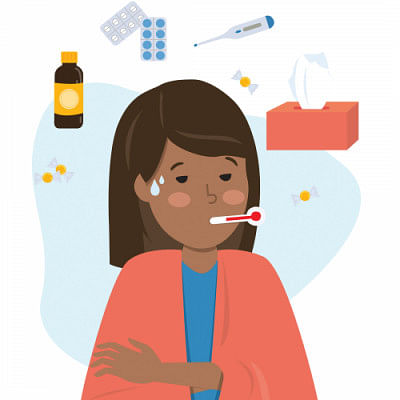What you need to know about the seasonal flu

Seasonal influenza is an acute respiratory infection caused by influenza viruses which circulate in all parts of the world.
There are 4 types of seasonal influenza viruses, types A, B, C and D. Influenza A and B viruses circulate and cause seasonal epidemics of disease.
Signs and symptoms
Seasonal influenza is characterised by a sudden onset of fever, cough (usually dry), headache, muscle and joint pain, sore throat and a runny nose. The cough can be severe and can last 2 or more weeks. Most people recover from fever and other symptoms within a week without requiring medical attention. But influenza can cause severe illness or death especially in people at high risk.
Epidemiology
Pregnant women, children under 59 months, the elderly, individuals with chronic medical conditions and individuals with immunosuppressive conditions (such as HIV/AIDS, receiving chemotherapy or steroids, or malignancy) are at greater risk of severe disease or complications when infected.
Health care workers are at high risk acquiring influenza virus infection due to increased exposure to the patients and risk further spreading particularly to vulnerable individuals.
In terms of transmission, seasonal influenza spreads easily, with rapid transmission in crowded areas. When an infected person coughs or sneezes, droplets containing viruses (infectious droplets) are dispersed into the air and can spread up to one meter, and infect persons in proximity who breathe these droplets in. The virus can also be spread by hands contaminated with influenza viruses.

Diagnosis
The majority of cases of human influenza are clinically diagnosed.
Collection of appropriate respiratory samples and the application of a laboratory diagnostic test is required to establish a definitive diagnosis.
Treatment
Non high-risk patients should receive symptomatic treatment and if symptomatic, should stay home to avoidinfecting others. Treatment focuses on relieving symptoms..If a patient's condition worsens, they should seek medical help.. Patients that are known to be in a group at high risk, should be treated with antivirals in addition to symptomatic treatment as soon as possible.
Prevention
The most effective way to prevent the disease is vaccination.
World Health Organisation (WHO) recommends annual vaccination for:
• pregnant women at any stage of pregnancy
• children aged between 6 months to 5 years
• elderly individuals (aged more than 65 years)
• individuals with chronic medical conditions
• health-care workers.
Apart from vaccination and antiviral treatment, the public health management includes personal protective measures like:
• Regular hand washing with proper drying of the hands
• Good respiratory hygiene – covering mouth and nose when coughing or sneezing, using tissues and disposing of them correctly
• Early self-isolation of those feeling unwell, feverish and having other symptoms of influenza
• Avoiding close contact with sick people
• Avoiding touching one's eyes, nose or mouth
Research estimates that 99% of deaths in children under 5 years of age with influenza related lower respiratory tract infections are found in developing countries. To better prepare for the next influenza pandemic, WHO is continuously working to strengthen national, regional, and global influenza response capacities.

 For all latest news, follow The Daily Star's Google News channel.
For all latest news, follow The Daily Star's Google News channel. 



Comments